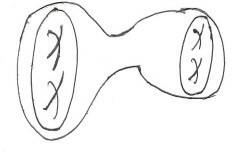Meiosis
• Meiosis involves two divisions of the parental cell resulting into four daughter cells.
• The mother cell has the diploid number of chromosomes.
• The four cells (gametes) have half the number of chromosomes (haploid) that the mother cell had.
• In the first meiotic division there is a reduction in the chromosome number because homologous chromosomes and not chromatids separate.
• Each division has four stages; Prophase, Metaphase, Anaphase and Telophase.
• This type of cell division takes place in reproductive organs (gonads) to produce gametes.
• The number of chromosomes in the gamete is half that in the mother cell
Interphase
• As in mitosis the cell prepares for division.
• This involves replication of chromosomes, organelles and builds up of energy to be used during the meiotic division.
First Meiotic division
Prophase I
• Homologous chromosomes lie side by side in the process of synapsis forming pairs called bivalents.
• Chromosomes shorten and thicken hence become more visible.
• Chromosomes may become coiled around each other and the chromatids may remain in contact at points called chiasmata (singular chiasma).
• Chromatids cross-over at the chiasmata exchanging chromatid portions. Important genetic changes usually result.

Metaphase I
• Spindle fibres are fully formed and attached to the centromeres.
• The bivalents move to the equator of the spindles.

Anaphase I
• Homologous chromosomes separate and migrate to opposite poles.
• This is brought about by shortening of spindle fibres hence pulling the chromosomes.
• The number of chromosomes at each pole is half the number in the mother cell.

Telophase I
• Cytoplasm divides to separate the two daughter cells.

Second Meiotic Division
• Usually the two daughter cells go into a short resting stage (interphase)
• But sometimes the chromosomes remain condensed and the daughter cells go straight into metaphase of second meiotic division.
• The second meiotic division takes place just like mitosis.
Prophase II
• Each chromosome is seen as a pair of chromatids.

Metaphase II
• Spindle forms and are attached to the chromatids at the centromeres.
• Chromatids move to the equator.

Anaphase II
• Sister chromatids separate from each other
• Then move to opposite poles, pulled by the shortening of the spindle fibres.

Telophase II
• The spindle apparatus disappears.
• The nucleolus reappears and nuclear membrane is formed around each set of chromatids.
• The chromatids become chromosomes.
• Cytoplasm divides and four daughter cells are formed.
• Each has a haploid number of chromosomes.

Significance of Meiosis
• Meiosis brings about formation of gametes that contain half the number of chromosomes as the parent cells.
• It helps to restore the diploid chromosomal constitution in a species at fertilisation.
• It brings about new gene combinations that lead to genetic variation in the offsprings.
• The mother cell has the diploid number of chromosomes.
• The four cells (gametes) have half the number of chromosomes (haploid) that the mother cell had.
• In the first meiotic division there is a reduction in the chromosome number because homologous chromosomes and not chromatids separate.
• Each division has four stages; Prophase, Metaphase, Anaphase and Telophase.
• This type of cell division takes place in reproductive organs (gonads) to produce gametes.
• The number of chromosomes in the gamete is half that in the mother cell
Interphase
• As in mitosis the cell prepares for division.
• This involves replication of chromosomes, organelles and builds up of energy to be used during the meiotic division.

First Meiotic division
Prophase I
• Homologous chromosomes lie side by side in the process of synapsis forming pairs called bivalents.
• Chromosomes shorten and thicken hence become more visible.
• Chromosomes may become coiled around each other and the chromatids may remain in contact at points called chiasmata (singular chiasma).
• Chromatids cross-over at the chiasmata exchanging chromatid portions. Important genetic changes usually result.

Metaphase I
• Spindle fibres are fully formed and attached to the centromeres.
• The bivalents move to the equator of the spindles.

Anaphase I
• Homologous chromosomes separate and migrate to opposite poles.
• This is brought about by shortening of spindle fibres hence pulling the chromosomes.
• The number of chromosomes at each pole is half the number in the mother cell.

Telophase I
• Cytoplasm divides to separate the two daughter cells.

Second Meiotic Division
• Usually the two daughter cells go into a short resting stage (interphase)
• But sometimes the chromosomes remain condensed and the daughter cells go straight into metaphase of second meiotic division.
• The second meiotic division takes place just like mitosis.
Prophase II
• Each chromosome is seen as a pair of chromatids.

Metaphase II
• Spindle forms and are attached to the chromatids at the centromeres.
• Chromatids move to the equator.

Anaphase II
• Sister chromatids separate from each other
• Then move to opposite poles, pulled by the shortening of the spindle fibres.

Telophase II
• The spindle apparatus disappears.
• The nucleolus reappears and nuclear membrane is formed around each set of chromatids.
• The chromatids become chromosomes.
• Cytoplasm divides and four daughter cells are formed.
• Each has a haploid number of chromosomes.

Significance of Meiosis
• Meiosis brings about formation of gametes that contain half the number of chromosomes as the parent cells.
• It helps to restore the diploid chromosomal constitution in a species at fertilisation.
• It brings about new gene combinations that lead to genetic variation in the offsprings.